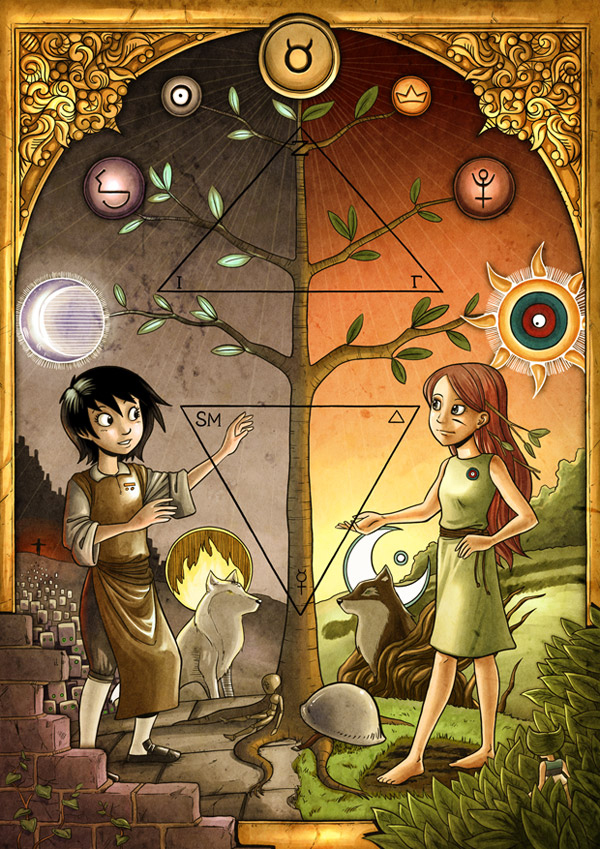Balloon & Panel: Online self-publishing companies offer new ways to fund projects

Tom Siddell’s “Gunnerkrigg Court” is a webcomic that follows friends Kat and Annie studying magic in a boarding school in England. (Courtesy of Tom Siddell)
By Joshua Greenberg
Jan. 28, 2015 1:30 a.m.
Comic books are everywhere – Marvel and DC Comics are mining decades of story lines for a huge slate of movies and television shows. But comics are more than a source to be mined for superhero blockbusters. New creators are dealing with issues every month in ways that couldn’t be done in other formats – issues of comic books.
It’s easy to publish online. It’s much more difficult to turn that into a career.
The old model of publisher submissions isn’t going anywhere, but it’s no longer the only economically viable route to success. I can go online and find countless great webcomics, ranging from newspaper-like “gag cartoons” to serialized, long-running stories. They’re often more diverse and experimental than print comics, with the internet’s scroll-able canvas used for structures that would be impossible in print.
These self-published comics are funded by business models that are a more direct route to the reader. Talking to fans is now easily done through social media. Small print runs for books like a hardcover edition of Michelle Czajkowski’s “Ava’s Demon” were previously untenable because of the risk of not selling anything, and the need to pay upfront. Small print runs took the cost of the book’s manufacture upfront and later paid it back with sales. Kickstarter reverses this – if a project is a success, the money raised from Kickstarter is used to fund the book in advance. If there’s no interest, the project fails.
These projects don’t happen overnight. It’s a long career road to even a modest living. Self-publishing has disadvantages, too – manually shipping boxes and all the work involved in running a small business, with all the risk involved in selling fiction.
Whenever someone established in the industry gets asked how to “make it” in comics, I see the same answer: Post your best work online, publicize it and people might read it. The old theory goes that running a webcomic is an ongoing portfolio – it’s something that might get you hired somewhere else for freelance work. Most webcomics are put online for free as loss-leaders, in the hope that they’ll make up the money in other places. The best advertising in this space is often word of mouth.
The main source of income for many of these “free” webcomics are merchandise, print editions and shirts, sold through online storefronts like TopatoCo.
Many rely on Kickstarter, where backers of a project pledge for pre-orders on products that would not exist without their help. Printed book projects like Charlie Trotman’s “The Sleep of Reason” horror anthology use money beyond an initial goal to pay artists more.
There are general risks to Kickstarter – poorly-planned projects can go bust without delivering their promised product, leaving backers out cold. That’s more of a factor in projects where the project is incomplete, or man-power reliant, like in video games. More conventional pre-orders for print versions of webcomics are far less likely to bust. Still, I’d never give money to a project that I don’t trust.
More direct is Patreon, which allows users to give a small amount a month in order to see behind-the-scene things like sketchbooks and livestreams. The main product – the comic – is almost always free. People are giving money directly so that these people can make time for them away from other work, turning a loss-leader into a sustainable project.
It’s a return to historical ideas of patronage; thus the name “Patreon.” Few comic book writers and illustrators are making a living solely through the site. It’s definitely more for established creators. Moderate successes make a few hundred dollars a month, though there are outliers making more.
“Atomic Robo,” Brian Clevinger and Scott Wegener’s former print comic, relaunched as a webcomic this week, funded in part by a new Patreon. It’s the pulp adventures of Nikola Tesla’s robot son. The first volume is up online, and future volumes will likewise be published on their website. They’re going where the market is: The potential fan base from putting their work up for free greatly exceeded the number of people buying single issues of “Atomic Robo” through comic book shops. The idea is that these new readers will then give them money directly, through Patreon, or by buying graphic novels.
There are more ways than ever to support the work I enjoy.
I like reading things online. New economic models are bringing these together. The huge surge in the number of viable webcomics means a healthier, more diverse marketplace.
What webcomics do you read? Email [email protected], or tweet at @joshdgreenberg.
***
Three “Must Read” Webcomics
Neurotic encyclopedia salesman Wadsworth Zane moves to the quaint Northeastern town of Broodhollow in Kris Straub’s strip. The abominations he finds there are definitely all in his head.
Antimony, a deeply reserved girl, and Kat, her robot-making best friend, attend an immense, labyrinthine boarding school in the north of England for the scientific study of magic. Tom Siddell weaves together alchemy, robots and folktale.
Jason Shiga’s screwed-up masterpiece would be rated R if it were an action movie. Jimmy Yee hangs himself in a hotel room after a botched robbery – and wakes up unharmed. He tries again, and can’t seem to die. How far will he go with this ability?


